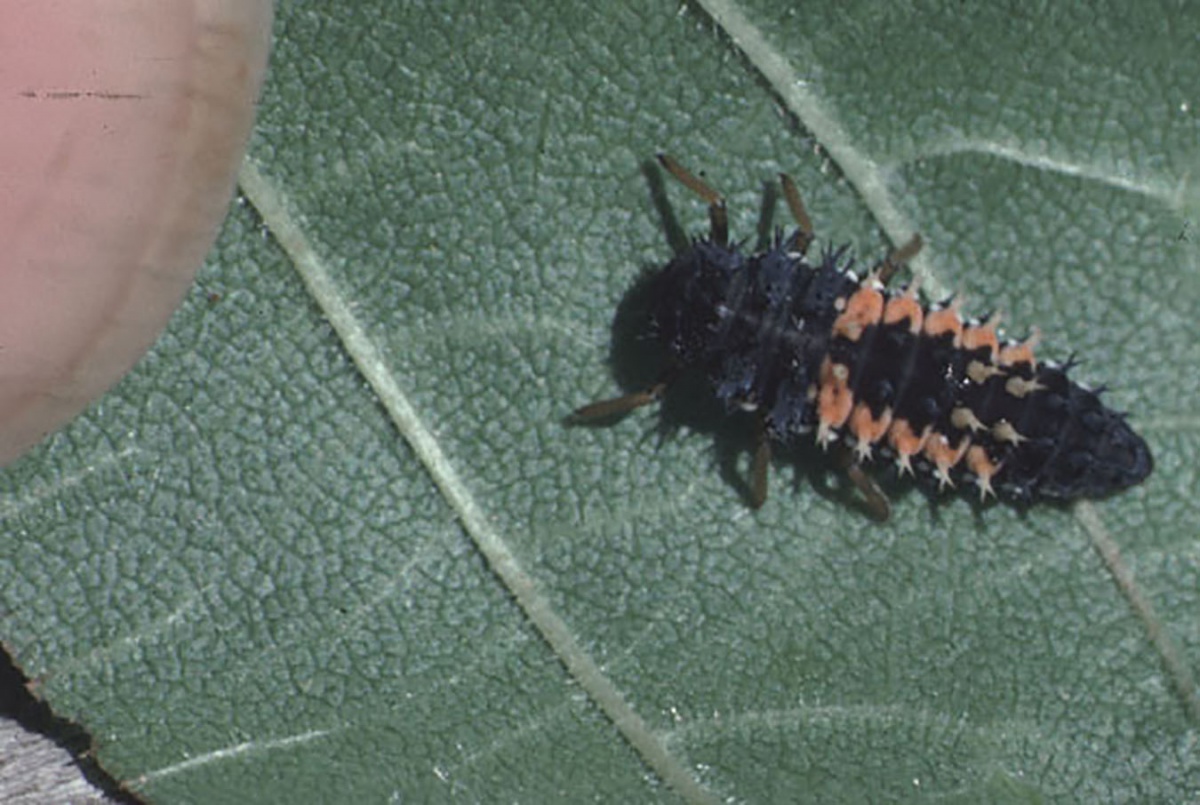Description
In 1994 a new ladybug appeared in New Hampshire. Known to scientists as Harmonia axyridis (Pallas), this insect is now common in all of the New England states.
Harmonia axyridis is highly variable in appearance. Most specimens in New Hampshire are orange to reddish-orange (sometimes tan) with anywhere from none to as many as 18 black spots on their wing covers. Since the background color and number of spots is variable, identification is easier when you look at the pronotum, the part of the back directly behind the head. It is usually whitish with black marks that form the shape of a capital M.Larvae of this species are similar to other ladybug larvae. They remind many people of alligators (except for the color!). For this species, the larvae are mostly black, with rows of Y-shaped tubercles on the back. Some tubercles are orange, and some are black.
Background
Scientists believe these insects reached the United States as stowaways on ship(s). The first US discovery was in the New Orleans area in 1988. Its most rapid spread was to the Northeast, possibly arriving in New Hampshire in the fall of 1993.
In the 1970’s, the Asian lady beetle was intentionally released as a biological control experiment in the US and Canada, because of its value in eating aphids and other insects. None of the intentional releases was successful. No survivors were found after a few months.
This insect is very beneficial as a predator of aphids and other small soft-bodied insects such as whiteflies. We find it commonly in corn fields, crops of melons, peppers and tomatoes, where it helps to protect these crops against insect pests. The Asian lady beetle and its larvae spend a lot of time in trees. We commonly find them in apple orchards as well as in ornamental trees such as tulip tree.

This insect is very beneficial as a preda- tor of aphids and other small soft bod- ied insects such as whiteflies.
Nuisance Management
This insect can also be a nuisance. In the fall large numbers may gather on the outside of buildings as they search for suitable overwintering sites. When one beetle finds conditions that are suitable, it gives off a chemical signal, called a pheromone, that attracts others of the same species. If your home is not well caulked, they invite themselves indoors, sometimes massing in large numbers piled up on each other.
To prevent ladybugs from getting indoors, thoroughly seal cracks and crevices to the outside before mid-September. Pay careful attention to areas around doors and windows, since lights also attract the insects. They often slip under sliding doors or through (large) drainage holes around screens and storm windows.
Air conditioners are a common point of entry; the openings are rarely screened. Because lady beetles clog up air conditioners, it’s a good idea to check inside your air conditioners in fall and early spring. If the beetles are especially bad on a doorway, use a different door during the daytime for a while. The ladybugs will be most numerous on the sunny side of buildings on mild days from mid-September through early November. Occasionally they are carried indoors on firewood, especially if the wood has been stacked against the house.
If lady beetles invade your home, sweep or vacuum them up and take them outside. There are no repellents to make the insects leave. We do not recommend controlling them by spraying insecticides on or inside buildings.
Did You Know? We do not recommend con- trolling them by spraying insecticides on or inside buildings.
Live Storage
Some people want to hold the ladybugs over the winter and release them in the greenhouse in the spring. We have little experience with this species, but here are some suggestions. You might have success by placing crumpled paper or narrow paper strips in a large glass jar. The paper creates lots of surface area for the beetles to use.
Add a small piece of slightly damp sponge, occasionally remoistened to keep the humidity from getting too low. Be careful not to add too much water or fungus will grow. For this reason, some people prefer to add one or two green leaves as a moisture source instead of damp paper or a sponge.
When their home is prepared, add ladybugs, seal the jar tightly and store in a cold place. Temperatures in the 30’s or 40’s (F) are probably okay.
Occasionally reopen the jar to check on the beetles. As an alternative use cloth or netting for a lid if you keep the jar in a cool damp place. Modern refrigerators are too dry inside to use a cloth or netting top. Do not keep ladybugs confined in a warm place for long. They really need to be cold. With luck, the ladybugs will be fine when it is time to release them.
Download the resource for the complete fact sheet.

